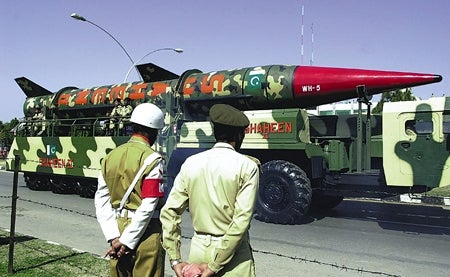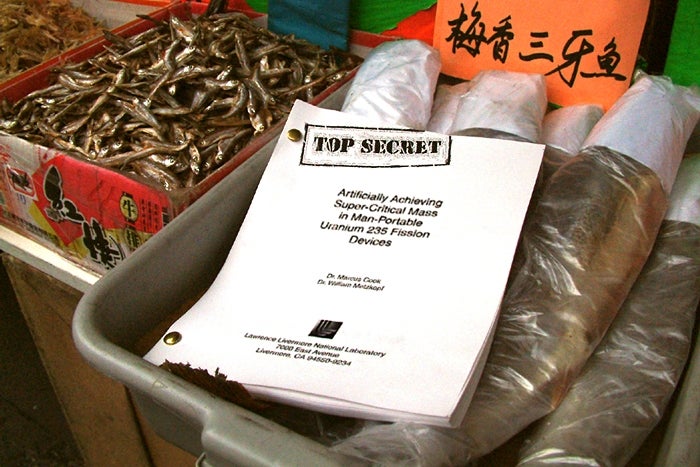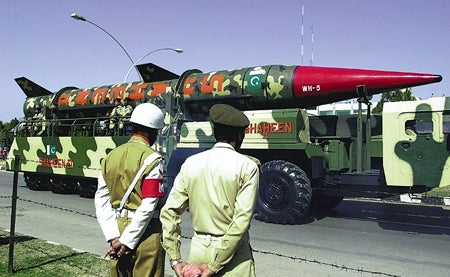WASHINGTON, DC—Top-secret information about the design, construction, and delivery of nuclear weapons has never been more affordable than it is today, CIA Director George Tenet announced Monday.

“We’re seeing items like warhead blueprints and uranium-enrichment instructions go for a fraction of what they used to cost,” Tenet said. “There’s never been a better time to snag a deal on low-mass, high-yield weaponry schematics. Countries like Iran and North Korea are finding that it’s a real buyer’s market.”
Tenet said he expects prices to continue to decline.
“These bargain prices will create more buyers, which will in turn widen the black market to include more sellers,” Tenet said. “If this trend continues, then by 2010, nuclear secrets will be well within the reach of Uzbekistan, Morocco, and pretty much anyone else with enough money to buy a used car.”
The trend toward cheaper, more readily available nuclear secrets began in the early ’90s, when Pakistani scientists sold plans and equipment for uranium-refining gas centrifuges to Iran and Iraq. While the price initially hovered around $100 million, the expanding market quickly drove prices down.
“Three years ago, a complete W-88 warhead data suite went to the Chinese for a sum in the mid-nine figures,” CIA nuclear-weapons specialist Mitch Romano said. “Now, you can pick up that W-88 data in Central Asia for a tenth of that cost—and they’ll deliver it free.”
Romano cited another example of plunging prices.
“About six months ago, one of our wiretaps recorded the sale of plans for a two-foot, 12-megaton warhead to a Quebecois separatist cell for slightly more than $1 million,” Romano said. “Yesterday, the plans surfaced again, this time on the Internet. It was eBay item #2899538529, and it had a ’Buy it now’ price of $18,500.”
Romano assured the public that the CIA has the seller, a San Diego-based car-audio retailer with the screen name of BatVette65, under strict surveillance.
“He’s got tons of new deals every week,” Romano said. “Right now, he’s got plans for an artillery-launched supergun nuke and a set of blueprints for cool old vintage Soviet-era silos.”
Romano said that, although prices are plunging, quality is improving.
“We’re not talking about a waist-high stack of floppy disks storing instructions for some clunky old atom bomb,” Romano said. “We’re talking detailed specs on a U.S.-produced Special Atomic Demolition Munitions suitcase device. Those are great little bombs that you can’t even get on the straight market anymore, because of the Spratt-Furse law.”
Martin Woess, an atomic-intelligence branch operative from Great Britain’s MI-6, said prices are so low that virtually any political organization that wants a nuclear program can afford one.

“Last week, we investigated reports that a cell in Edinburgh had sold classified British intelligence information to an American group,” Woess said. “The group turned out to be the Young Republicans organization at the University of Virginia.”
“NATO has since classified the group as a Class D potential nuclear threat,” Woess added.
At least one intelligence expert expressed trepidation over the booming nuclear-secrets economy.
“It was an embarrassment to our country that Abdul Qadeer Khan sold nuclear secrets and technology to Iran, Libya, and North Korea,” said General Mohammed Kanazwa, a senior officer for Pakistani military intelligence. “But it was all the more embarrassing when we found out that he had sold them in the ’Bargains Under $100’ section of the Cleveland Plain Dealer.”
As dire as the news may seem, Tenet stressed the difference between acquiring the technical know-how necessary to build a nuclear-weapons program and actually initiating such a program.
“Although nuclear-weapons intelligence may be selling for less than a thousandth of its Cold War price, the buyer would still require qualified personnel and hard-to-find materials to actually construct a device,” Tenet said. “They may be able to get plans for a bomb for a few pennies, but weapons-grade plutonium, when available, sells for hundreds, sometimes thousands of dollars a pound.”







